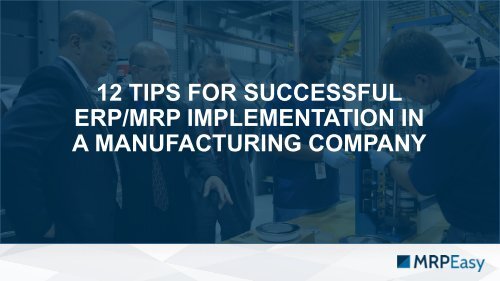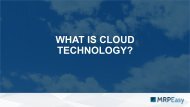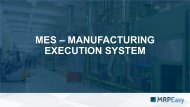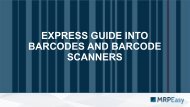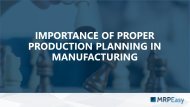12 Tips for successful implementation of ERP in a Manufacturing Company
You also want an ePaper? Increase the reach of your titles
YUMPU automatically turns print PDFs into web optimized ePapers that Google loves.
<strong>12</strong> TIPS FOR SUCCESSFUL<br />
<strong>ERP</strong>/MRP IMPLEMENTATION IN<br />
A MANUFACTURING COMPANY
1. COMPANY SIZE MATTERS<br />
Not every company is ready to implement an <strong>ERP</strong>/MRP system anytime.<br />
This is especially true <strong>for</strong> micro-companies (up to 10 employees). Such<br />
companies may not have enough resources and competence <strong>for</strong> the <strong>ERP</strong>/MRP<br />
system <strong>in</strong>stallation and operation.<br />
Also, the outcome <strong>of</strong> us<strong>in</strong>g an <strong>ERP</strong> s<strong>of</strong>tware <strong>in</strong> such company can be less than<br />
expected.
2. AVOID MICROTASKING<br />
<strong>ERP</strong>/MRP system is <strong>in</strong>tended to solve major problems associated with<br />
manufactur<strong>in</strong>g, so try to identify important tasks, s<strong>in</strong>ce they will have the most<br />
impact while focus<strong>in</strong>g on micro-automation will lead to more complexity <strong>of</strong> the<br />
<strong>implementation</strong> project.<br />
Set a limited number <strong>of</strong> major <strong>implementation</strong> project goals which should be<br />
closely related to the bus<strong>in</strong>ess processes and problems that you want to solve.<br />
Don’t waste time and energy on tasks which look nice, but have a small impact.<br />
Goals should relate to the bus<strong>in</strong>ess, rather than automation itself.
3. ALLOCATE ENOUGH RESOURCES<br />
The <strong>ERP</strong>/MRP system <strong>implementation</strong> process is a one-time, but quite a big<br />
project, so allocate resources accord<strong>in</strong>gly.<br />
Set a project manager <strong>for</strong> the <strong>implementation</strong> process with enough time<br />
resources, as well as with experience <strong>in</strong> <strong>ERP</strong>/MRP s<strong>of</strong>tware.<br />
All heads <strong>of</strong> departments that will use the system should be <strong>in</strong>cluded <strong>in</strong> the<br />
<strong>implementation</strong> project team.
4. <strong>ERP</strong> IMPLEMENTATION STEP BY STEP<br />
Depend<strong>in</strong>g on your company’s size and structure, you can implement the<br />
system by module, by functionality and by personnel, <strong>for</strong> example.<br />
Example:<br />
In the beg<strong>in</strong>n<strong>in</strong>g the managers report about f<strong>in</strong>ished manufactur<strong>in</strong>g orders on<br />
their own be<strong>for</strong>e pass<strong>in</strong>g this function to l<strong>in</strong>e workers.
5. DATA CLASSIFICATION<br />
Th<strong>in</strong>k over data classification and categorization.<br />
Create logical product groups.<br />
It is near impossible to change data classification after <strong>in</strong>stallation.
6. KEEP TESTING &<br />
IMPLEMENTATION APART<br />
Have a clear understand<strong>in</strong>g – are you test<strong>in</strong>g, or implement<strong>in</strong>g the <strong>ERP</strong> with<br />
real data already.<br />
Us<strong>in</strong>g real data dur<strong>in</strong>g the test<strong>in</strong>g period will make the process overcomplicated.<br />
Clean<strong>in</strong>g the database if the data are mixed with test data might be<br />
problematic.
7. CUSTOMIZATION IS NOT THE<br />
ONLY WAY<br />
It is practically impossible to f<strong>in</strong>d an <strong>ERP</strong> solution that would suit all the<br />
needs and align perfectly with your exist<strong>in</strong>g bus<strong>in</strong>ess processes and<br />
documents. In most cases you have to adapt or customize.<br />
Though customization might seem as the simplest solution, on practice<br />
adapt<strong>in</strong>g your bus<strong>in</strong>ess processes could be more effective, and may deliver<br />
better results <strong>in</strong> the long-run.
8. KEEP ALL FUTURE USERS<br />
INFORMED ABOUT PROJECT GOALS<br />
AND SCHEDULE<br />
Make sure that all the users that will be <strong>in</strong>teract<strong>in</strong>g with the <strong>ERP</strong> system<br />
have a clear understand<strong>in</strong>g <strong>of</strong> <strong>implementation</strong> goals and schedule.<br />
This means that one general meet<strong>in</strong>g <strong>in</strong> the beg<strong>in</strong>n<strong>in</strong>g <strong>of</strong> <strong>implementation</strong><br />
should be held with periodic communication to follow.
9. USERS MUST BE TRAINED<br />
Every person <strong>in</strong>teract<strong>in</strong>g with the <strong>ERP</strong> s<strong>of</strong>tware should be aware <strong>of</strong> what<br />
one is do<strong>in</strong>g. Usually the first one or two tra<strong>in</strong>ed users pass the knowledge<br />
to others.<br />
Another option would be s<strong>of</strong>tware vendor’s tra<strong>in</strong><strong>in</strong>gs.
10. EXPERIENCE WITH <strong>ERP</strong>/MRP<br />
SYSTEMS HELPS<br />
The <strong>implementation</strong> project team leader should have prior experience with<br />
us<strong>in</strong>g and/or implement<strong>in</strong>g <strong>ERP</strong> systems <strong>in</strong> your specific <strong>in</strong>dustry.<br />
If you don’t have such a person, then it is good to f<strong>in</strong>d a partner consult<strong>in</strong>g<br />
company with such experience.
11. NO RUSH – TEST & TEST AGAIN<br />
Test <strong>in</strong>tensively prior to start us<strong>in</strong>g an <strong>ERP</strong> system <strong>in</strong> production mode.<br />
It is much easier to fix errors dur<strong>in</strong>g the test<strong>in</strong>g period than dur<strong>in</strong>g operat<strong>in</strong>g<br />
with real data.
<strong>12</strong>. KEEP OLD SYSTEM FOR A WHILE<br />
It is better to use the old system <strong>in</strong> parallel with the new one <strong>for</strong> at least 1-2<br />
months after hav<strong>in</strong>g implemented the new <strong>ERP</strong> s<strong>of</strong>tware.<br />
This helps to make sure that the new solution has been configured and is<br />
be<strong>in</strong>g used properly, <strong>for</strong> example the reports <strong>in</strong> old and new systems are<br />
identical.<br />
Also, <strong>in</strong> case <strong>of</strong> major issues with the new system you will be able to roll<br />
back to the old.<br />
Hope this helps! Let us know if you have any questions.
MRPEasy Cloud <strong>ERP</strong>/MRP Solution<br />
• Production plann<strong>in</strong>g and report<strong>in</strong>g<br />
• Supply cha<strong>in</strong> management<br />
• Stock management<br />
• CRM<br />
• Managerial statistics, bus<strong>in</strong>ess <strong>in</strong>telligence<br />
• Integration with onl<strong>in</strong>e account<strong>in</strong>g solutions<br />
Easy to deploy and use! Visit us @ www.mrpeasy.com


